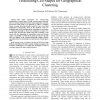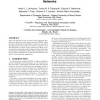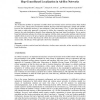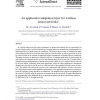IEEECIT
2010
IEEE
13 years 10 months ago
2010
IEEE
This paper investigates the energy-saving organization of sensor nodes in large wireless sensor networks. Due to a random deployment used in many application scenarios, much more n...
IEEECIT
2010
IEEE
13 years 10 months ago
2010
IEEE
—Distributed computing systems often strive to decouple their communicating components (threads on a single node, or nodes in a network) from each other with respect to time, spa...
GIS
2010
ACM
13 years 10 months ago
2010
ACM
Top-k queries are a popular type of query in Wireless Sensor Networks. Typical solutions rely on coordinated root-tonodes and nodes-to-root messages and on maintaining filters at...
SAC
2008
ACM
13 years 11 months ago
2008
ACM
We present an analogy between the operation of a Wireless Sensor Network and the sampling and reconstruction of a signal. We measure the impact of three factors on the quality of ...
SAC
2008
ACM
13 years 11 months ago
2008
ACM
This work presents the use of sensor stream reduction algorithms in clustered wireless sensor networks (WSNs), where the cluster head node is responsible to reduce the amount of d...
RAS
2007
13 years 11 months ago
2007
The localization problem is important in mobile robots and wireless sensor network and has been studied for many years. Among many localization methods, the hop-count based approa...
PERCOM
2007
ACM
13 years 11 months ago
2007
ACM
In wireless sensor networks, poor performance or unexpected behavior may be experienced for several reasons, such as trivial deterioration of sensing hardware, unsatisfactory impl...
NETWORK
2007
13 years 11 months ago
2007
Surveillance wireless sensor networks are deployed at perimeter or border locations to detect unauthorized intrusions. For deterministic deployment of sensors, the quality of depl...
IJSNET
2008
13 years 11 months ago
2008
Abstract: This paper addresses the target coverage problem in wireless sensor networks. Communication and sensing consume energy, therefore efficient power management can extend ne...
TMC
2002
13 years 11 months ago
2002




